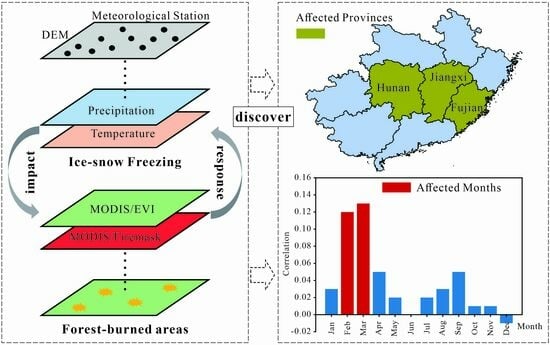Spatio-Temporal Characteristics of Ice–Snow Freezing and Its Impact on Subtropical Forest Fires in China
Abstract
:1. Introduction
2. Study Area and Datasets
2.1. Study Area
2.2. Data Sources and Preprocessing
3. Study Methods
3.1. MODIS/EVI Patching Algorithm
3.2. Freezing Information Extraction
3.3. Extraction of Forest-Burned Areas
3.4. Spatial Autocorrelation Analysis
3.4.1. Global Autocorrelation Analysis
3.4.2. Local Autocorrelation Analysis
3.5. Forest Fire Response to Ice–Snow Freezing
4. Results
4.1. Spatial and Temporal Pattern of Ice–Snow Freezing
4.2. Forest Fire Distribution Patterns during 2001–2019
5. Discussion
5.1. Spatial Impact of Ice–Snow Freezing on Forest Fires in Subtropical China
5.2. Temporal Impact of Ice–Snow Freezing on Forest Fires in Subtropical China
6. Conclusions
Author Contributions
Funding
Data Availability Statement
Acknowledgments
Conflicts of Interest
Appendix A
| Year | Zhejiang | Anhui | Fujian | Jiangxi | Hubei | Hunan | Guangdong | Gaungxi | Guizhou |
|---|---|---|---|---|---|---|---|---|---|
| 2001 | 1498.40 | 133.70 | 2413.10 | 2161.70 | 845.60 | 1628.70 | 964.90 | 756.80 | 1452.00 |
| 2002 | 2479.80 | 229.40 | 4938.90 | 2034.40 | 538.40 | 3423.00 | 1023.00 | 1713.10 | 2727.70 |
| 2003 | 5257.90 | 150.50 | 4634.40 | 6408.20 | 570.60 | 9088.80 | 1633.10 | 4807.30 | 3250.70 |
| 2004 | 10,838.90 | 1047.90 | 13,589.80 | 12,711.20 | 1618.30 | 15,852.80 | 2886.20 | 4997.60 | 2040.60 |
| 2005 | 6945.00 | 1169.00 | 3429.00 | 4627.00 | 1709.00 | 12,931.00 | 1419.00 | 2467.00 | 2045.00 |
| 2006 | 2066.80 | 173.00 | 1316.40 | 1073.00 | 943.40 | 4988.70 | 1038.90 | 1344.70 | 1848.90 |
| 2007 | 1567.00 | 277.00 | 2119.00 | 2054.00 | 1117.00 | 8004.00 | 1125.00 | 2274.00 | 1779.00 |
| 2008 | 4040.00 | 579.00 | 7967.00 | 6934.00 | 1605.00 | 17,781.00 | 1452.00 | 1420.00 | 4440.00 |
| 2009 | 1580.00 | 311.00 | 11,011.00 | 3300.00 | 473.00 | 10,110.00 | 1269.00 | 1190.00 | 3702.00 |
| 2010 | 361.00 | 393.00 | 1449.00 | 729.00 | 589.00 | 4893.00 | 304.00 | 1600.00 | 9102.00 |
| 2011 | 2090.00 | 255.00 | 6503.00 | 1435.00 | 677.00 | 3605.00 | 1476.00 | 883.00 | 910.00 |
| 2012 | 906.00 | 86.00 | 700.00 | 412.00 | 236.00 | 4653.00 | 361.00 | 780.00 | 502.00 |
| 2013 | 1271.00 | 158.00 | 1373.00 | 751.00 | 215.00 | 2824.00 | 679.00 | 594.00 | 411.00 |
| 2014 | 786.00 | 265.00 | 1145.00 | 1579.00 | 185.00 | 1935.00 | 930.00 | 1241.00 | 488.00 |
| 2015 | 301.00 | 5.00 | 1416.00 | 335.00 | 29.00 | 285.00 | 1300.00 | 1769.00 | 607.00 |
| 2016 | 261.00 | 76.00 | 221.00 | 190.00 | 117.00 | 316.00 | 287.00 | 1090.00 | 37.00 |
| 2017 | 251.00 | 47.00 | 319.00 | 707.00 | 217.00 | 961.00 | 733.00 | 1351.00 | 42.00 |
| 2018 | 117.18 | 17.20 | 577.53 | 478.67 | 194.16 | 649.06 | 969.45 | 1232.52 | 74.84 |
| 2019 | 115.54 | 42.35 | 478.67 | 489.14 | 385.86 | 864.90 | 1118.58 | 918.03 | 18.79 |
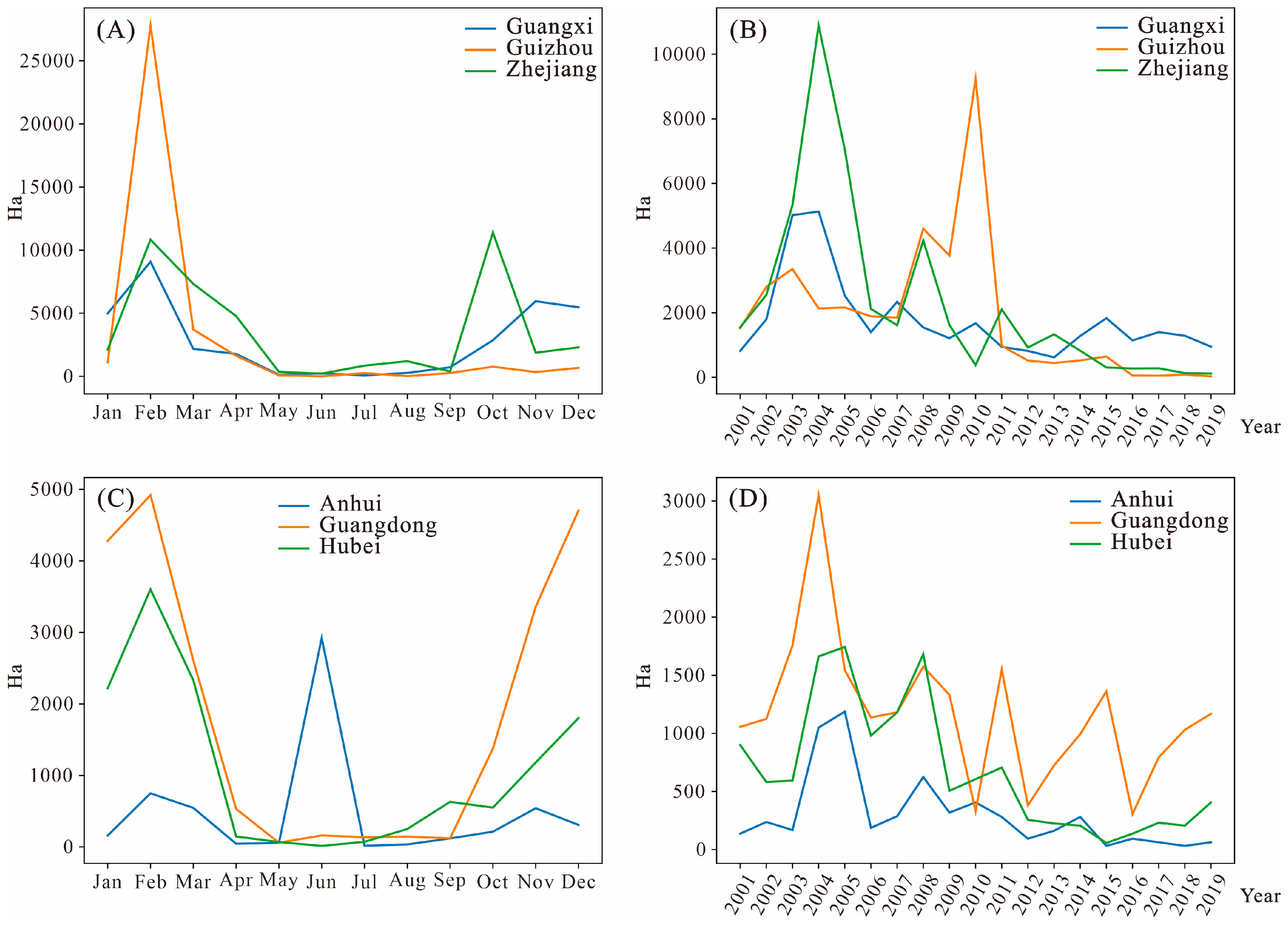
References
- Seidl, R.; Thom, D.; Kautz, M.; Dario, M.B.; Peltoniemi, M.; Vacchiano, G.; Wild, J.; Ascoli, D.; Per, M.; Honkaniemi, J.; et al. Forest disturbances under climate change. Nat. Clim. Change 2017, 7, 395–402. [Google Scholar] [CrossRef]
- Anderegg, W.R.L.; Trugman, A.T.; Badgley, G.; Anderson, C.M.; Bartuska, A.; Ciais, P.; Cullenward, D.; Field, C.; Freeman, J.; Geotz, S.J.; et al. Climate-driven risks to the climate mitigation potential of forests. Science 2020, 368, eaaz7005. [Google Scholar] [CrossRef]
- Abatzoglou, J.T.; Williams, A.P. Impact of anthropogenic climate change on wildfire across western US forests. Proc. Natl. Acad. Sci. USA 2016, 113, 11770–11775. [Google Scholar] [CrossRef] [PubMed]
- Williams, A.P.; Abatzoglou, J.T.; Gershunov, A.; Janin, G.M.; Bishp, D.A.; Balch, J.K.; Lettenmaier, D.P. Observed impacts of anthropogenic climate change on wildfire in California. Earth’s Future 2019, 7, 892–910. [Google Scholar] [CrossRef]
- Halofsky, J.E.; Peterson, D.L.; Harvey, B.J. Changing wildfire, changing forests: The effects of climate change on fire regimes and vegetation in the Pacific Northwest, USA. Fire Ecol. 2020, 16, 4. [Google Scholar] [CrossRef]
- Heinrich, V.H.A.; Dalagnol, R.; Cassol, H.L.G.; Rosan, T.M.; Almeida, C.T.; Junior, C.H.L.; Campanharo, W.A.; House, J.I.; Sitch, S.; Hales, T.C.; et al. Large carbon sink potential of secondary forests in the Brazilian Amazon to mitigate climate change. Nat. Commun. 2021, 12, 1785. [Google Scholar] [CrossRef]
- Canadell, J.G.; Meyer, C.P.; Cook, G.D.; Dowdy, A.; Briggs, P.R.; Knauer, J.; Pepler, A.; Haverd, V. Multi-decadal increase of forest burned area in Australia is linked to climate change. Nat. Commun. 2021, 12, 6921. [Google Scholar] [CrossRef]
- Shao, Y.; Wang, Z.; Feng, Z.; Yang, X.; Zheng, J.; Ma, T. Assessment of China’s forest fire occurrence with deep learning, geographic information and multisource data. J. For. Res. 2023, 34, 963–976. [Google Scholar] [CrossRef]
- Boer, M.M.; Resco’de, D.V.; Bradstock, R.A. Unprecedented burn area of Australian mega forest fires. Nat. Clim. Change 2020, 10, 171–172. [Google Scholar] [CrossRef]
- Urrutia-Jalabert, R.; González, M.E.; González-Reyes, Á.; Antonio, L.; Rene, G. Climate variability and forest fires in central and south-central Chile. Ecosphere 2018, 9, e02171. [Google Scholar] [CrossRef]
- Holden, Z.A.; Swanson, A.; Luce, C.H.; Jolly, W.M.; Maneta, M.; Oyler, J.W.; Warren, D.A.; Parsons, R.; Affleck, D. Decreasing fire season precipitation increased recent western US forest wildfire activity. Proc. Natl. Acad. Sci. USA 2018, 115, E8349–E8357. [Google Scholar] [CrossRef]
- Xu, R.; Lin, H.; Lu, K.; Cao, L.; Liu, Y. A forest fire detection system based on ensemble learning. Forests 2021, 12, 217. [Google Scholar] [CrossRef]
- Ruthrof, K.X.; Fontaine, J.B.; Matusick, G.; Breshears, D.D.; Law, D.J.; Powell, S.; Hardy, G. How drought-induced forest die-off alters microclimate and increases fuel loadings and fire potentials. Int. J. Wildland Fire 2016, 25, 819–830. [Google Scholar] [CrossRef]
- Page, Y.L.; Morton, D.; Hartin, C.; Bond-Lamberty, B.; Pereira, J.M.C.; Hurtt, G.; Asrar, G. Synergy between land use and climate change increases future fire risk in Amazon forests. Earth Syst. Dynam. 2017, 8, 1237–1246. [Google Scholar] [CrossRef]
- Sargis, G.; Adams, K. Effects of an ice storm on fuel loadings and potential fire behavior in a pine barren of northeastern New York. Sci. Discipulorum 2004, 1, 17–25. [Google Scholar]
- Bragg, D.C.; Shelton, M.G.; Zeide, B. Impacts and management implications of ice storms on forests in the southern United States. For. Ecol. Manag. 2003, 186, 99–123. [Google Scholar] [CrossRef]
- Harrington, T.B. Long-term effects of thinning and woody control on longleaf pine plantation development, understory abundance, and tree damage from an ice storm. For. Ecol. Manag. 2020, 459, 117846. [Google Scholar] [CrossRef]
- Trotsiuk, V.; Hartig, F.; Cailleret, M.; Babst, F.; Forrester, D.; Baltensweiler, A.; Buchmann, N.; Bugmann, H.; Gessler, A.; Gharun, M.; et al. Assessing the response of forest productivity to climate extremes in Switzerland using model–data fusion. Glob. Change Biol. 2020, 26, 2463–2476. [Google Scholar] [CrossRef]
- Contosta, A.R.; Casson, N.J.; Garlick, S.; Nelson, S.J.; Ayres, M.P. Northern forest winters have lost cold, snowy conditions that are important for ecosystems and human communities. Ecol. Appl. 2019, 29, e01974. [Google Scholar] [CrossRef]
- Chen, F.; Feng, H.; Xue, L.; Pan, L.; Xu, P.; Liu, B. Impact of ice-snow damage on nutrient distribution of a Cunninghamia lanceolata woodland. J. For. Res. 2010, 21, 207–212. [Google Scholar] [CrossRef]
- Wang, X.; Yang, F.; Gao, X.; Wang, W.; Zha, X. Evaluation of forest damaged area and severity caused by ice-snow frozen disasters over southern China with remote sensing. Chin. Geogr. Sci. 2019, 29, 405–416. [Google Scholar] [CrossRef]
- Shao, Q.; Huang, L.; Liu, J.; Li, J. Analysis of forest damage caused by the snow and ice chaos along a transect across southern China in spring 2008. J. Geogr. Sci. 2011, 21, 219–234. [Google Scholar] [CrossRef]
- Liu, F.; Yang, Z.; Zhang, G. Canopy gap characteristics and spatial patterns in a subtropical forest of South China after ice storm damage. J. Mt. Sci.-Engl. 2020, 17, 1942–1958. [Google Scholar] [CrossRef]
- Guo, J.; Cui, J.; Wu, N.; Zhang, Y.; Wang, J.; Xiang, H.; Hu, B.; Zhou, Y. Ice storm damage to oak forests in subtropical China. For. Ecosyst. 2023, 13, 100119. [Google Scholar] [CrossRef]
- Tang, X.; Xia, M.; Pérez-Cruzado, C.; Guan, F.; Fan, S. Spatial distribution of soil organic carbon stock in Moso bamboo forests in subtropical China. Sci. Rep. 2017, 7, 42640. [Google Scholar] [CrossRef]
- Yao, X.; Yu, K.; Deng, Y.; Zeng, Q.; Lai, Z.; Liu, J. Spatial distribution of soil organic carbon stocks in Masson pine (Pinus massoniana) forests in subtropical China. Catena 2019, 178, 189–198. [Google Scholar] [CrossRef]
- Sarmah, S.; Jia, G.; Zhang, A.; Singha, M. Assessing seasonal trends and variability of vegetation growth from NDVI3g, MODIS NDVI and EVI over South Asia. Remote Sens. Lett. 2018, 9, 1195–1204. [Google Scholar] [CrossRef]
- Zhang, J.; Xiao, J.; Tong, X.; Zhang, J.; Meng, P.; Li, J.; Liu, P.; Yu, P. NIRv and SIF better estimate phenology than NDVI and EVI: Effects of spring and autumn phenology on ecosystem production of planted forests. Agric. For. Meteorol. 2022, 315, 819–836. [Google Scholar] [CrossRef]
- Kong, D.; Zhang, Y.; Gu, X.; Wang, D. A robust method for reconstructing global MODIS EVI time series on the Google Earth Engine. ISPRS J. Photogramm. 2019, 155, 13–24. [Google Scholar] [CrossRef]
- Yang, J.; Huang, X. The 30 m annual land cover dataset and its dynamics in China from 1990 to 2019. Earth Syst. Sci. Data 2021, 13, 3907–3925. [Google Scholar] [CrossRef]
- Liu, Y.; Yuan, X.; Li, J.; Qian, K.; Yan, W.; Yang, X.; Ma, X. Trade-offs and synergistic relationships of ecosystem services under land use change in Xinjiang from 1990 to 2020: A Bayesian network analysis. Sci. Total Environ. 2023, 858, 160015. [Google Scholar] [CrossRef]
- Su, Y.; Guo, Q. A practical method for SRTM DEM correction over vegetated mountain areas. ISPRS J. Photogramm. 2014, 87, 216–228. [Google Scholar] [CrossRef]
- Schroeder, W.; Csiszar, I.; Morisette, J. Quantifying the impact of cloud obscuration on remote sensing of active fires in the Brazilian Amazon. Remote Sens. Environ. 2008, 112, 456–470. [Google Scholar] [CrossRef]
- Jönsson, P.; Eklundh, L. TIMESAT—A program for analyzing time-series of satellite sensor data. Comput. Geosci. 2004, 30, 833–845. [Google Scholar] [CrossRef]
- Li, L.; Friedl, M.A.; Xin, Q.; Gray, J.; Pan, Y.; Frolking, S. Mapping crop cycles in China using MODIS-EVI time series. Remote Sens. 2014, 6, 2473–2493. [Google Scholar] [CrossRef]
- Ghassemian, H. A review of remote sensing image fusion methods. Inf. Fusion 2016, 32, 75–89. [Google Scholar] [CrossRef]
- Guo, B.; Zhang, J.; Meng, X.; Xu, T.; Song, Y. Long-term spatio-temporal precipitation variations in China with precipitation surface interpolated by ANUSPLIN. Sci. Rep. 2020, 10, 81. [Google Scholar] [CrossRef]
- Tan, J.; Xie, X.; Zuo, J.; Xing, X.; Liu, B.; Xia, Q.; Zhang, Y. Coupling random forest and inverse distance weighting to generate climate surfaces of precipitation and temperature with multiple-covariates. J. Hydrol. 2021, 598, 126270. [Google Scholar] [CrossRef]
- Chu, T.; Guo, X. Compositing MODIS time series for reconstructing burned areas in the taiga–steppe transition zone of northern Mongolia. Int. J. Wildland Fire 2015, 24, 419–432. [Google Scholar] [CrossRef]
- Hardtke, L.A.; Blanco, P.D.; Valle, H.F.; Metternicht, G.I.; Sione, W.F. Semi-automated mapping of burned areas in semi-arid ecosystems using MODIS time-series imagery. Int. J. Appl. Earth Obs. 2015, 38, 25–35. [Google Scholar] [CrossRef]
- Michael, Y.; Helman, D.; Glickman, O.; Gabay, D.; Brenner, S.; Lensky, I.M. Forecasting fire risk with machine learning and dynamic information derived from satellite vegetation index time-series. Sci. Total Environ. 2021, 764, 142844. [Google Scholar] [CrossRef]
- Gao, L.; Wang, X.; Johnson, B.A.; Tian, Q.; Wang, Y.; Verrelst, J.; Mu, X.; Gu, X. Remote sensing algorithms for estimation of fractional vegetation cover using pure vegetation index values: A review. ISPRS J. Photogramm. 2020, 159, 364–377. [Google Scholar] [CrossRef]
- Deng, Y.; Wang, M.; Yousefpour, R.; Hanewinkel, M. Abiotic disturbances affect forest short-term vegetation cover and phenology in Southwest China. Ecol. Indic. 2021, 124, 107393. [Google Scholar] [CrossRef]
- Lim, C.H.; Kim, Y.S.; Won, M.; Kim, S.J.; Lee, W.K. Can satellite-based data substitute for surveyed data to predict the spatial probability of forest fire? A geostatistical approach to forest fire in the Republic of Korea. Geomat. Nat. Haz. Risk 2019, 10, 719–739. [Google Scholar] [CrossRef]
- Tariq, A.; Shu, H.; Siddiqui, S.; Mousa, B.G.; Munir, I.; Nasri, A.; Waqas, H.; Lu, L.; Baqa, M.F. Forest fire monitoring using spatial-statistical and Geo-spatial analysis of factors determining forest fire in Margalla Hills, Islamabad, Pakistan. Geomat. Nat. Haz. Risk 2021, 12, 1212–1233. [Google Scholar] [CrossRef]
- Liu, M.; Feng, F.; Cai, T.; Tang, S. Soil microbial community response differently to the frequency and strength of freeze–thaw events in a Larix gmelinii Forest in the Daxing’an mountains, China. Front. Microbiol. 2020, 11, 1164. [Google Scholar] [CrossRef] [PubMed]
- Watanabe, T.; Tateno, R.; Imada, S.; Fukuzawa, K.; Isobe, K.; Urakawa, R.; Oda, T.; Hosokawa, N.; Sasai, T.; Hishi, T.; et al. The effect of a freeze–thaw cycle on dissolved nitrogen dynamics and its relation to dissolved organic matter and soil microbial biomass in the soil of a northern hardwood forest. Biogeochemistry 2019, 142, 319–338. [Google Scholar] [CrossRef]
- Fang, K.; Yao, Q.; Guo, Z.; Zheng, B.; Du, J.; Qi, F.; Yan, P.; Li, J.; Ou, T.; Liu, J.; et al. ENSO modulates wildfire activity in China. Nat. Commun. 2021, 12, 1764. [Google Scholar] [CrossRef]
- Liu, Z.; Ballantyne, A.P.; Cooper, L.A. Increases in land surface temperature in response to fire in Siberian boreal forests and their attribution to biophysical processes. Geophys. Res. Lett. 2018, 45, 6485–6494. [Google Scholar] [CrossRef]
- Michetti, M.; Pinar, M. Forest fires across Italian regions and implications for climate change: A panel data analysis. Environ. Resour. Econ. 2019, 72, 207–246. [Google Scholar] [CrossRef]
- Çolak, E.; Sunar, F. Evaluation of forest fire risk in the Mediterranean Turkish forests: A case study of Menderes region, Izmir. Int. J. Disaster Risk Reduct. 2020, 45, 101479. [Google Scholar] [CrossRef]
- Xiong, Q.; Luo, X.; Liang, P.; Xiao, Y.; Xiao, Q.; Sun, H.; Pan, K.; Wang, L.; Li, L.; Pan, X. Fire from policy, human interventions, or biophysical factors? Temporal–spatial patterns of forest fire in southwestern China. For. Ecol. Manag. 2020, 474, 118381. [Google Scholar] [CrossRef]
- Xu, X.K. Effect of freeze-thaw disturbance on soil C and N dynamics and GHG fluxes of East Asia forests: Review and future perspectives. Soil Sci. Plant Nutr. 2022, 68, 15–26. [Google Scholar] [CrossRef]
- Wang, M.Y.; Shu, L.F.; Zhao, F.J.; Wang, Q.H.; Yan, H.; Dai, X.A.; Tian, X.R. Quantity analysis of forest fuel under the impacts of snow damage in South of China-Case study in Hunan Province. Sci. Silvae Sin. 2008, 44, 69–74. (In Chinese) [Google Scholar]
- Liu, C.; Chen, L.; Tang, W.; Peng, S.; Li, M.; Deng, N.; Chen, Y. Predicting potential distribution and evaluating suitable soil condition of oil tea Camellia in China. Forests 2018, 9, 487. [Google Scholar] [CrossRef]
- Zhang, S.; Xiao, J.; Xu, Q. Regional precipitation variations during Heinrich events and Dansgaard-Oeschger cycles in the northern margin of the East Asian summer monsoon region. Quat. Sci. Rev. 2022, 278, 107380. [Google Scholar] [CrossRef]
- Pourghasemi, H.R.; Gayen, A.; Lasaponara, R.; Tiefenbacher, J.P. Application of learning vector quantization and different machine learning techniques to assessing forest fire influence factors and spatial modelling. Environ. Res. 2020, 184, 109321. [Google Scholar] [CrossRef]
- Hu, T.; Zhao, B.; Li, F.; Dou, X.; Hu, H.; Sun, L. Effects of fire on soil respiration and its components in a Dahurian larch (Larix gmelinii) forest in northeast China: Implications for forest ecosystem carbon cycling. Geoderma 2021, 402, 115273. [Google Scholar] [CrossRef]
- Senf, C.; Buras, A.; Zang, C.S.; Ramming, A.; Seidl, R. Excess forest mortality is consistently linked to drought cross Europe. Nat. Commun. 2020, 11, 6200. [Google Scholar] [CrossRef]
- Sevinc, V.; Kucuk, O.; Goltas, M. A Bayesian network model for prediction and analysis of possible forest fire causes. For. Ecol Manag. 2020, 457, 117723. [Google Scholar] [CrossRef]
- Chiodi, A.M.; Larkin, N.S.; Varner, J.M. An analysis of Southeastern US prescribed burn weather windows: Seasonal variability and EI Niño associations. Int. J. Wildland Fire. 2018, 27, 176–189. [Google Scholar] [CrossRef]
- Wang, M.; Shu, L.; Wang, Q.; Zhao, F.; Tian, X.; Yan, H.; Du, J. Forest fire occurrence in short term under the impacts of snow damage in south China—Case study in Hunan Province. Sci. Silvae Sin. 2008, 44, 64–68. (In Chinese) [Google Scholar]
- Peng, J.B.; Bueh, C.; Xie, Z.W. Extensive cold-precipitation-freezing events in southern China and their circulation characteristics. Adv. Atmos. Sci. 2021, 38, 81–97. [Google Scholar] [CrossRef]
- Zheng, Y.; Yang, Q.; Xu, M.; Chi, Y.; Shen, R.; Li, P.; Dai, H. Responses of Pinus massoniana and Pinus taeda to freezing in temperate forests in central China. Scand. J. For. Res. 2012, 27, 520–531. [Google Scholar] [CrossRef]
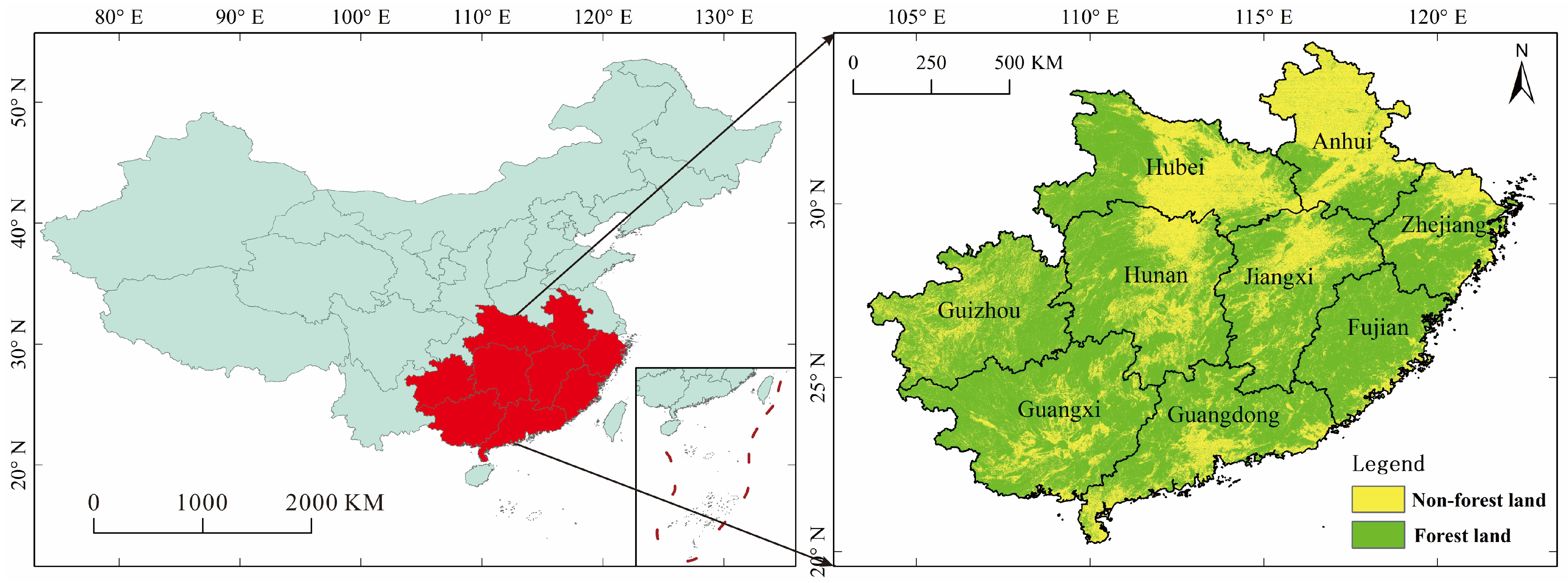
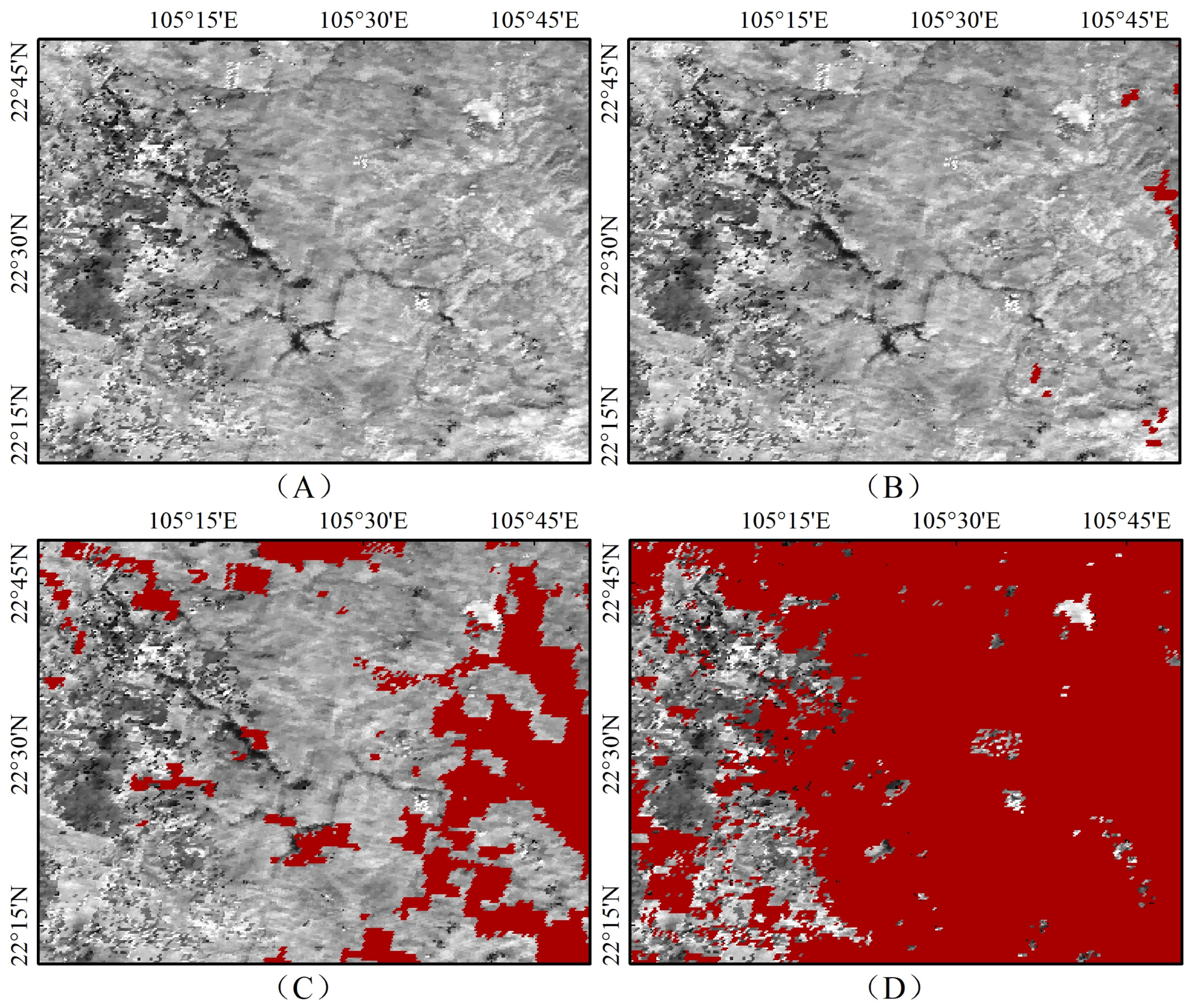
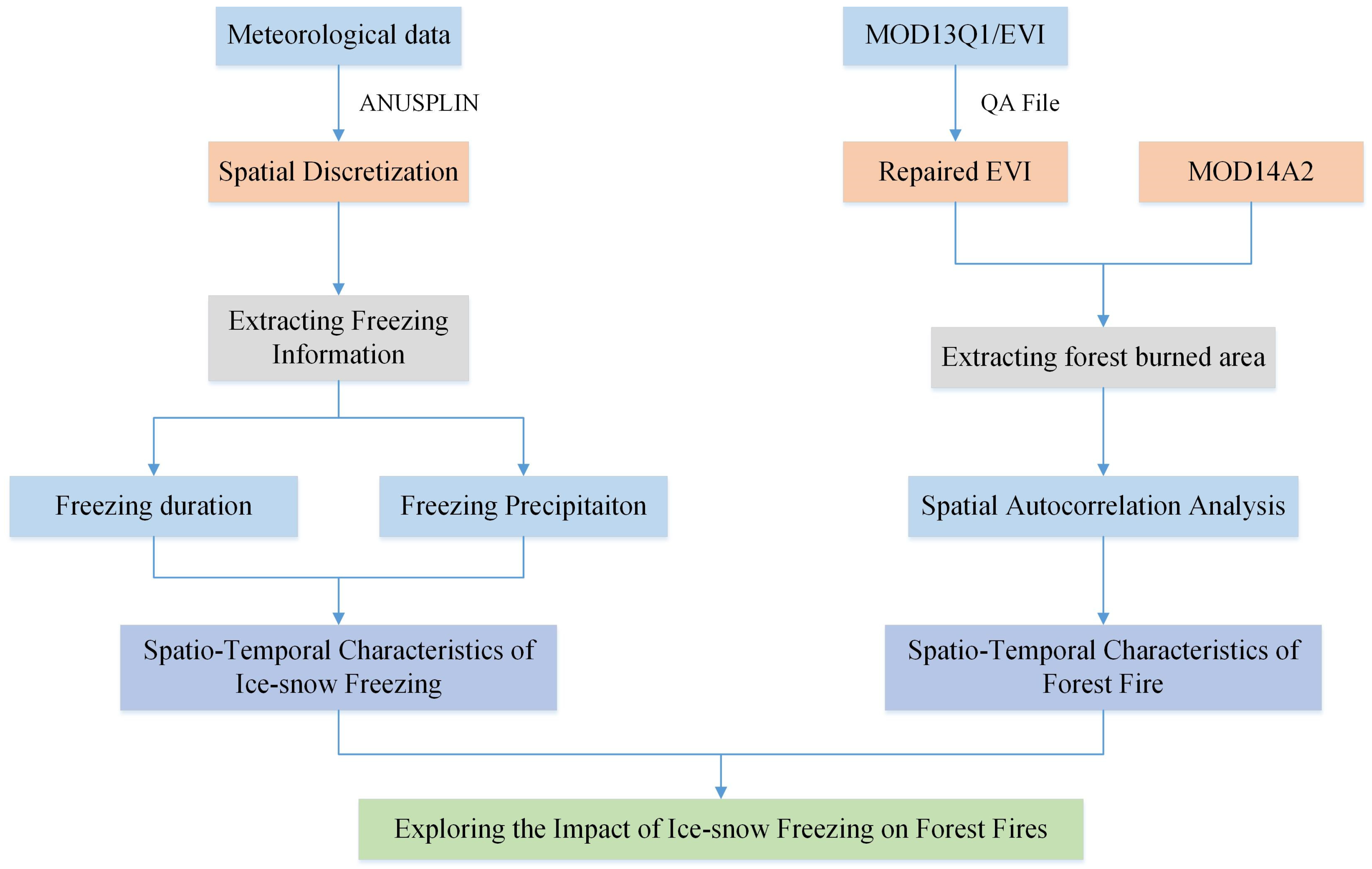
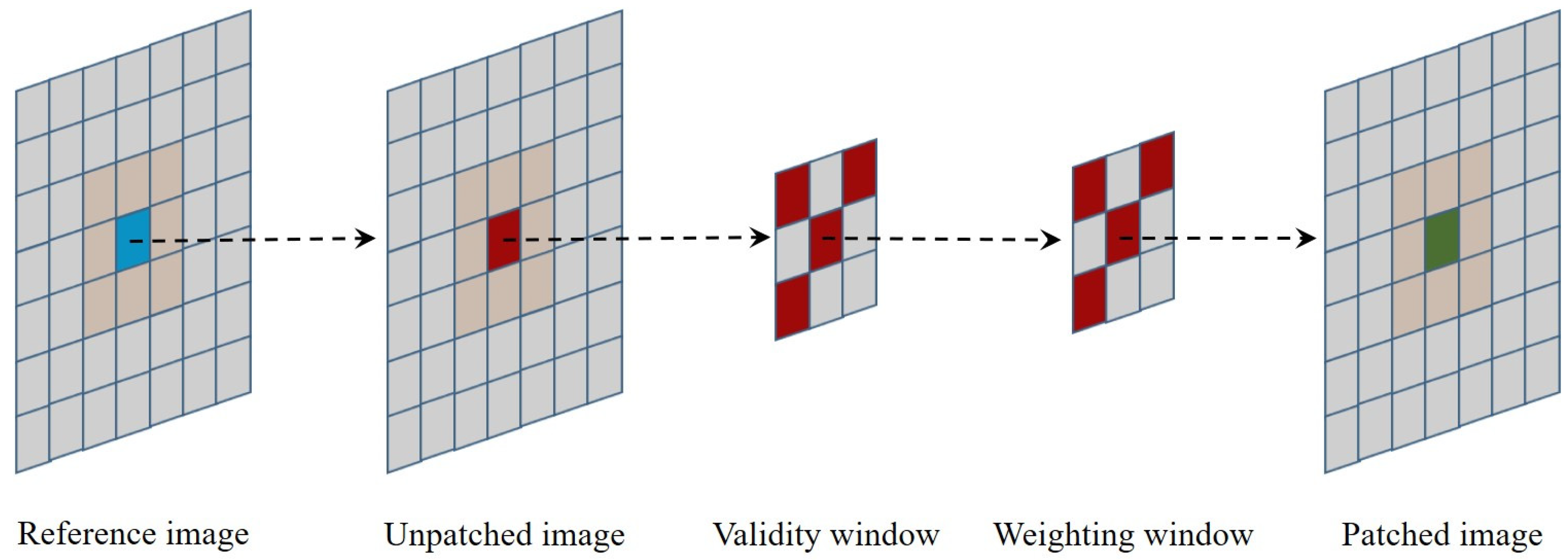

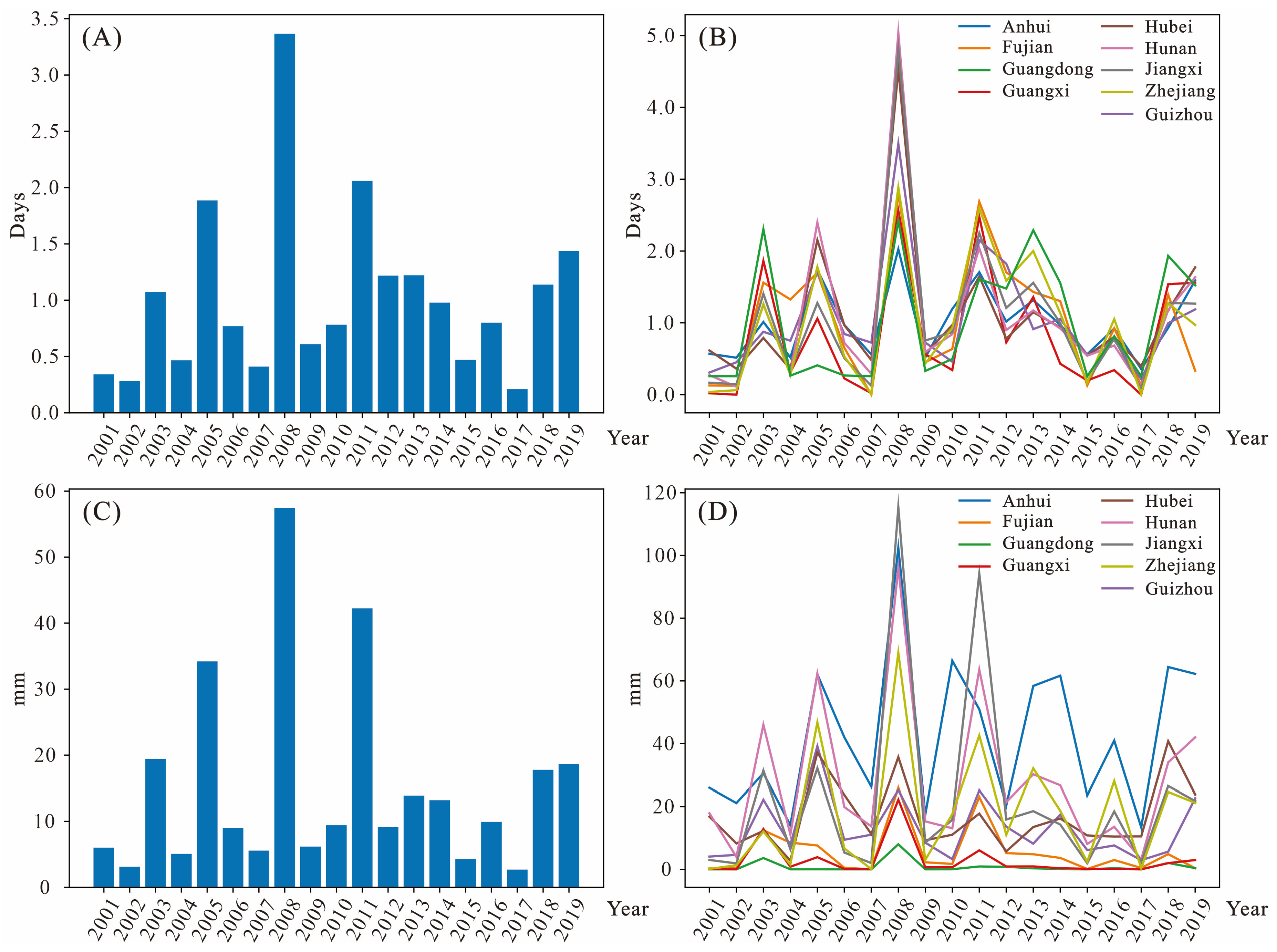
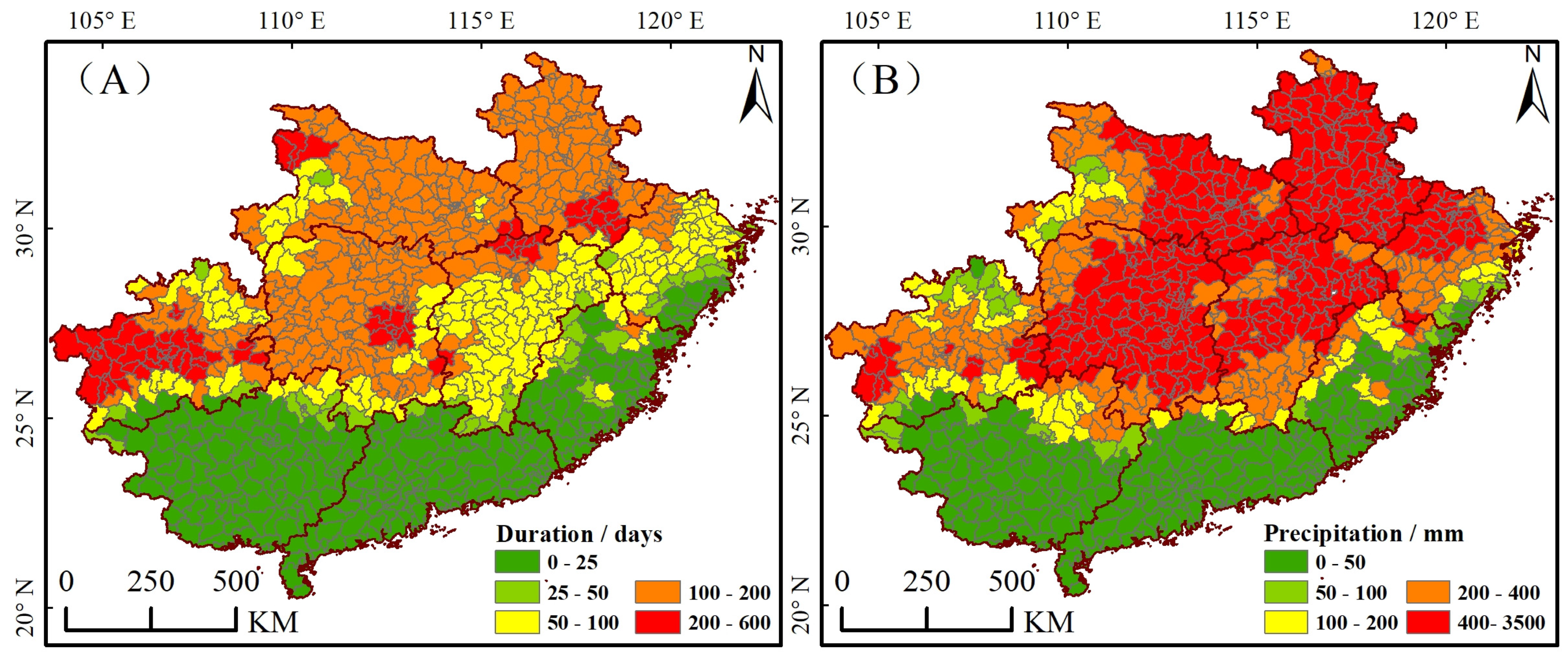
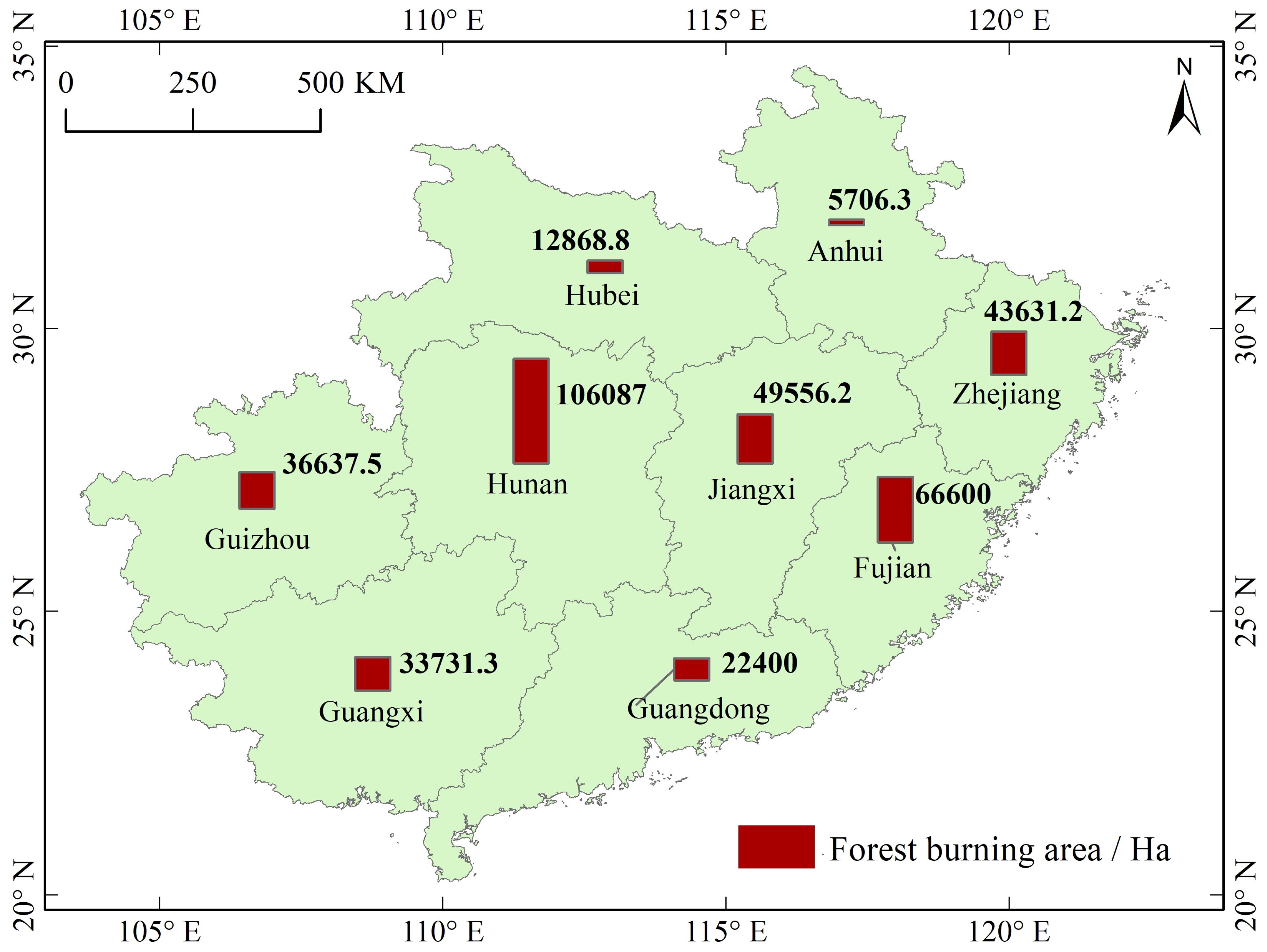
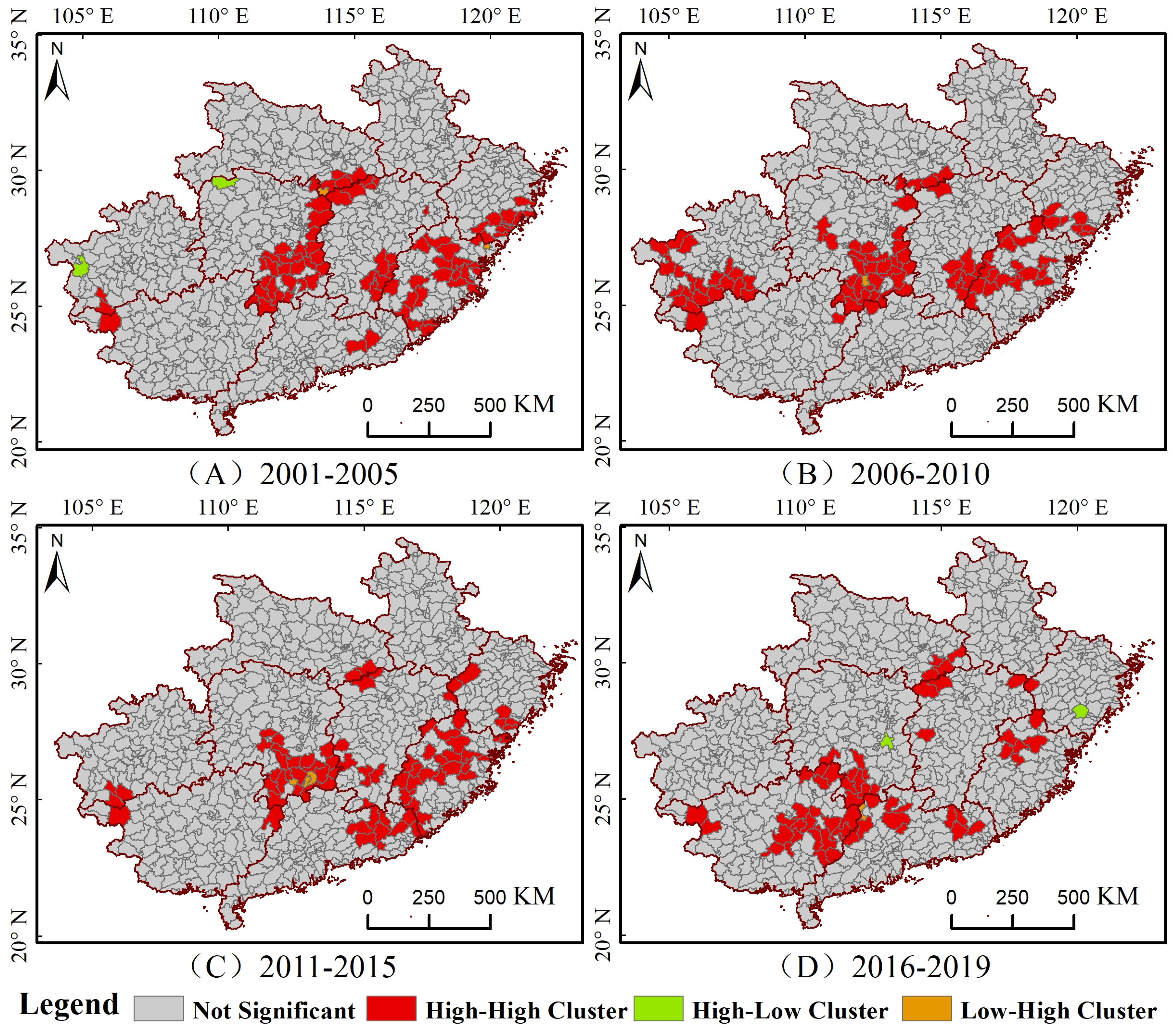


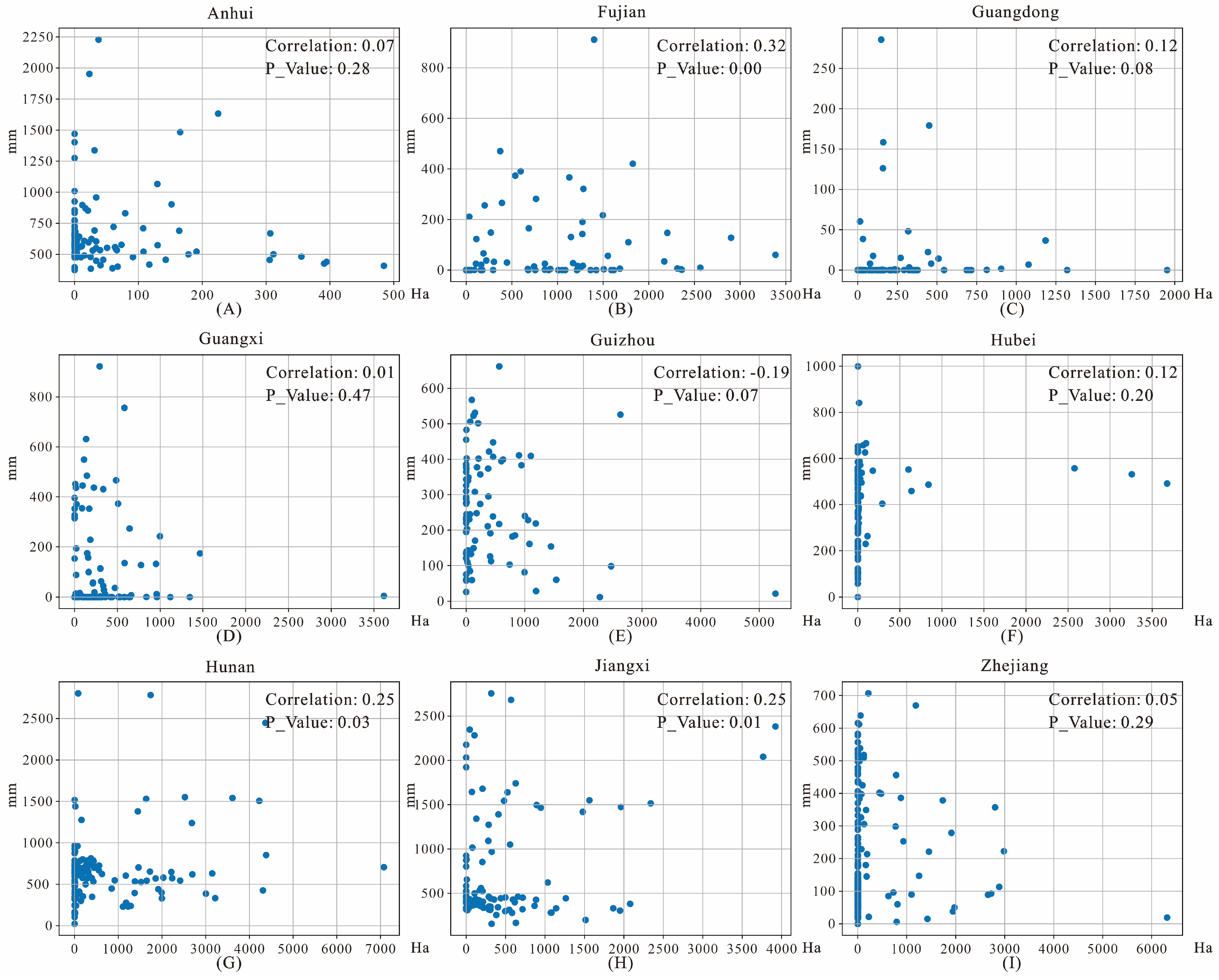

| Dataset | Time Scale | Spatio-Temporal Resolution |
|---|---|---|
| MOD13Q1 | 2001–2019 | 250 m/16 d |
| MOD14A2 | 2001–2019 | 1000 m/8 d |
| Meteorological station | 2000–2019 | -- |
| Land cover | 2001–2019 | 30 m |
| DEM | -- | 30 m |
| Bits 0–1: VI Quality | Bits 2–5: VI Usefulness | ||
|---|---|---|---|
| 0: VI produced with good quality | 0: Highest quality | 8: Decreasing quality | 13: Quality so low that it is not useful |
| 1: VI produced, but check other QA | 1: Lower quality | 9: Decreasing quality | 14: L1B data faulty |
| 2: Pixel produced, but most probably cloudy | 2: Decreasing quality | 10: Decreasing quality | 15: Not useful due to any other reason/not processed |
| 3: Pixel not produced due to other reasons than clouds | 4: Decreasing quality | 12: Lowest quality | |
| Year | Hunan | Jiangxi | Year | Hunan | Jiangxi |
|---|---|---|---|---|---|
| 2001 | 1681.25 | 2200.00 | 2011 | 3650.00 | 1456.25 |
| 2002 | 3518.75 | 2056.25 | 2012 | 4693.74 | 431.25 |
| 2003 | 9200.00 | 6468.75 | 2013 | 2862.50 | 775.00 |
| 2004 | 15,925.00 | 12,787.49 | 2014 | 1981.25 | 1637.50 |
| 2005 | 13,012.49 | 4681.25 | 2015 | 306.25 | 356.25 |
| 2006 | 5025.00 | 1106.25 | 2016 | 331.25 | 200.00 |
| 2007 | 8050.00 | 2106.25 | 2017 | 987.50 | 731.25 |
| 2008 | 18,150.00 | 7431.25 | 2018 | 675.00 | 506.25 |
| 2009 | 10,193.75 | 3350.00 | 2019 | 887.50 | 518.75 |
| 2010 | 4956.25 | 756.25 |
| Province | 2006 | 2007 | 2008 | 2009 | 2010 |
|---|---|---|---|---|---|
| Anhui | 187.50 | 287.50 | 625.00 | 318.75 | 406.25 |
| Fujian | 1325.00 | 2137.50 | 8012.50 | 11,050.00 | 1468.75 |
| Guangdong | 1137.50 | 1181.25 | 1575.00 | 1331.25 | 331.25 |
| Guangxi | 1400.00 | 2337.50 | 1543.75 | 1212.50 | 1675.00 |
| Guizhou | 1887.50 | 1850.00 | 4600.00 | 3768.75 | 9237.50 |
| Hubei | 981.25 | 1181.25 | 1681.25 | 506.25 | 606.25 |
| Hunan | 5025.00 | 8050.00 | 18,150.00 | 10,193.75 | 4956.25 |
| Jiangxi | 1106.25 | 2106.25 | 7431.25 | 3350.00 | 756.25 |
| Zhejiang | 2118.76 | 1612.50 | 4237.50 | 1618.75 | 381.25 |
Disclaimer/Publisher’s Note: The statements, opinions and data contained in all publications are solely those of the individual author(s) and contributor(s) and not of MDPI and/or the editor(s). MDPI and/or the editor(s) disclaim responsibility for any injury to people or property resulting from any ideas, methods, instructions or products referred to in the content. |
© 2023 by the authors. Licensee MDPI, Basel, Switzerland. This article is an open access article distributed under the terms and conditions of the Creative Commons Attribution (CC BY) license (https://creativecommons.org/licenses/by/4.0/).
Share and Cite
Wang, X.; Gao, X.; Wu, Y.; Jiang, H.; Wang, P. Spatio-Temporal Characteristics of Ice–Snow Freezing and Its Impact on Subtropical Forest Fires in China. Remote Sens. 2023, 15, 5118. https://doi.org/10.3390/rs15215118
Wang X, Gao X, Wu Y, Jiang H, Wang P. Spatio-Temporal Characteristics of Ice–Snow Freezing and Its Impact on Subtropical Forest Fires in China. Remote Sensing. 2023; 15(21):5118. https://doi.org/10.3390/rs15215118
Chicago/Turabian StyleWang, Xuecheng, Xing Gao, Yuming Wu, Hou Jiang, and Peng Wang. 2023. "Spatio-Temporal Characteristics of Ice–Snow Freezing and Its Impact on Subtropical Forest Fires in China" Remote Sensing 15, no. 21: 5118. https://doi.org/10.3390/rs15215118




